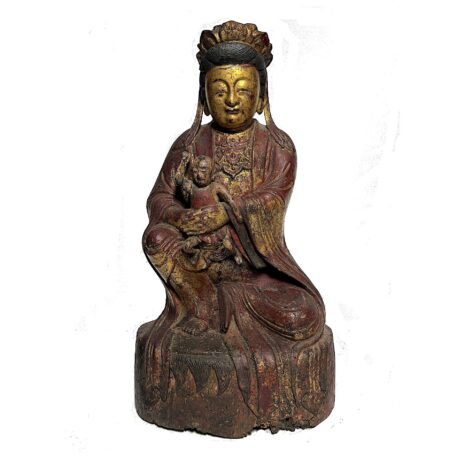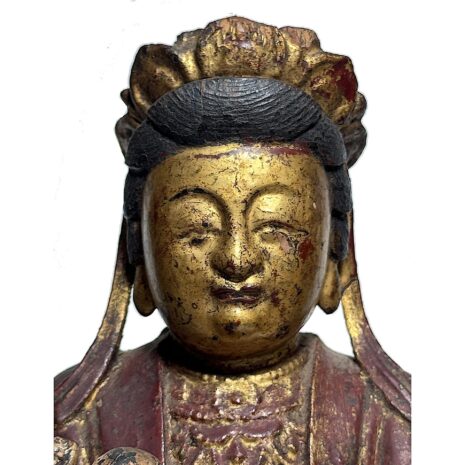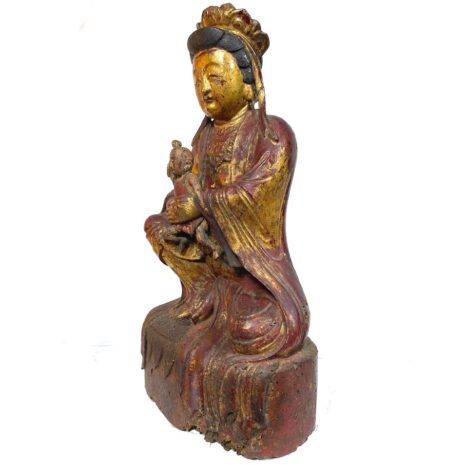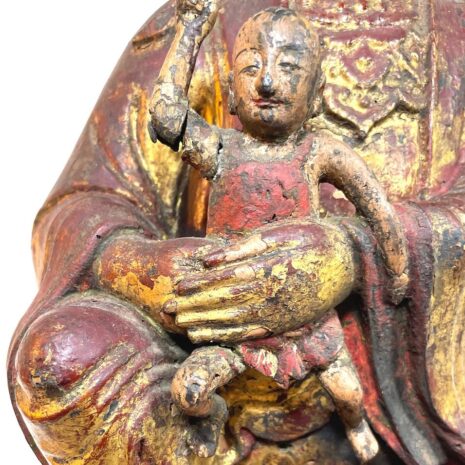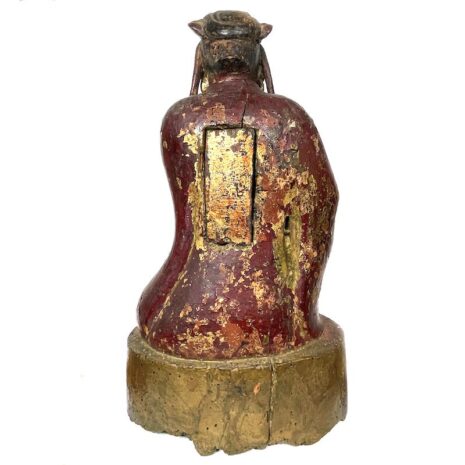Antique Songzi Guanyin, Bestower of Children, China (16311)
Original price was: $2,650.00.$1,975.00Current price is: $1,975.00.
H: 14.5” W: 8.25” D: 5” | CALL 213-568-3030 OR EMAIL [email protected] FOR SHIPPING.
Rare and beautiful provincial Songzi Guanyin is modest, compassionate and humble with lotus leaf crown, unadorned robe and pedestal with simple leaves. Her baby resembles the infant Buddha. Was probably on a home altar of wealthy couple desiring a (male) baby.
Description
During the Ming and Qing Dynasties, the cult of Songzi (“Child Giving”) Guanyin became one of China’s most popular religious movements, especially among Popular Religion and Taoist female devotees. It was embraced in all Chinese regions and social strata, including upper classes, court figures and literati as well as the rural peasant classes. In this manifestation, Guanyin holds a child in her lap symbolizing her roles in granting and raising children. She protects women and children during pregnancy and childbirth, prevents their premature illness or death and protects children after birth. Before Ming dynasty Guanyin rarely held a child in her lap. Confucian also greatly increased Songzi Guanyin’s importance by emphasizing that women should seek solace only from female deities especially in requests for off-spring. Holding a male child emphasized that a woman’s most important role is to produce male heirs.
Christian missionaries who arrived in China during the 15-17 centuries commissioned local artisans to carve Virgin and Mary images. Songzi images then began to resemble Mary holding baby Jesus. Before that time Guanyin did not hold her child.
Seated in “lalitsana,” the posture of royal ease, her deeply carved elegant robes flow over her pedestal. Her multi lobed crown of stylized lotus leaves covered with gilt and red pigment, and her pendulous ears indicate her regal and enlightened status. The red color of “fu” (blessings) and gilt are wishes for good luck and prosperity. Her elegant hands caress the child in her lap in the posture of the Buddha immediately after birth with his right hand up and his left pointing down.
As many Buddhist statues were lost or damaged during China’s modernization, this remarkable and beautiful statue is rare and in very good condition with most original gilt pigmentation and lacquer on the front and back. There are expected surface losses, small cracks and old stabilized insect damage and the baby’s arm has been glued together in more recent times. It was consecrated by a monk in an eye-opening ceremony and has its original flat cover.
This large provincial Guanyin display the best of China’s provincial traditions, with graceful serenity and compassion combined with relatable elegance.
Click here for the Blog Consecrating Wooden Images to Imbue Them with A Life Force
Additional information
| Period | Antique, Qing Dynasty |
|---|---|
| Date | 18-19th Century |
| Materials and Technique | Wood |
| Dimensions (inches) | Ht: 14.5” W: 8.25” D: 5” |
| Dimensions (metric) | Ht: 36.83cm W: 20.95cm D: 12.7cm |
| Weight | 3 lbs 9oz |
| Condition | Very good, see description |
| Item Number | 16311XOKE |
| Shipping Box Size | Oversized. Call 213-568-3030 or email [email protected] for shipping. |

